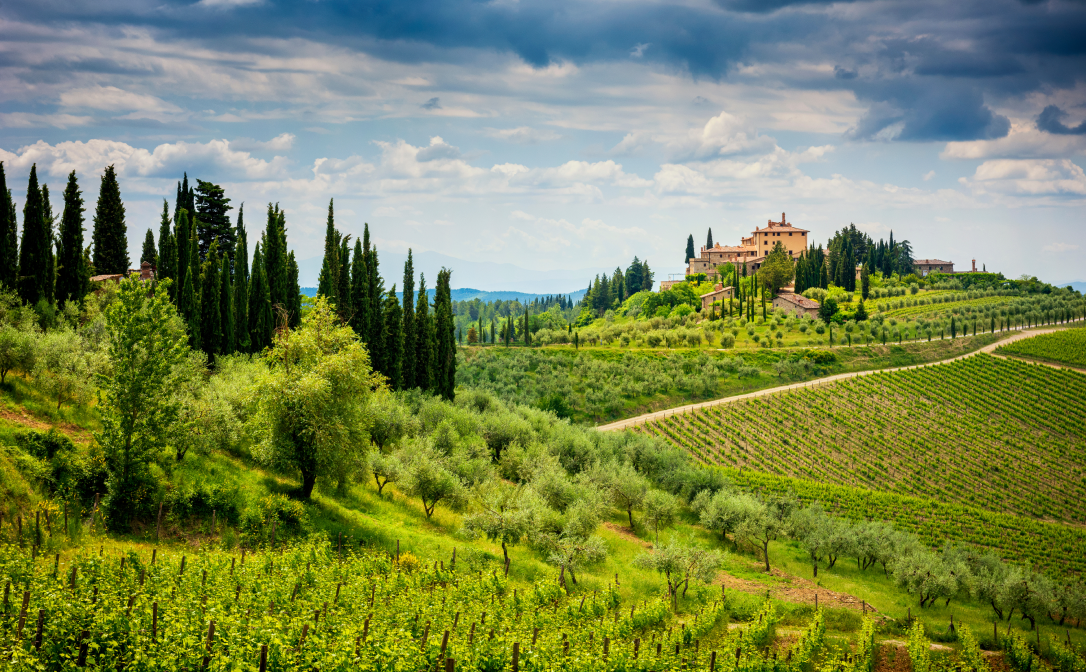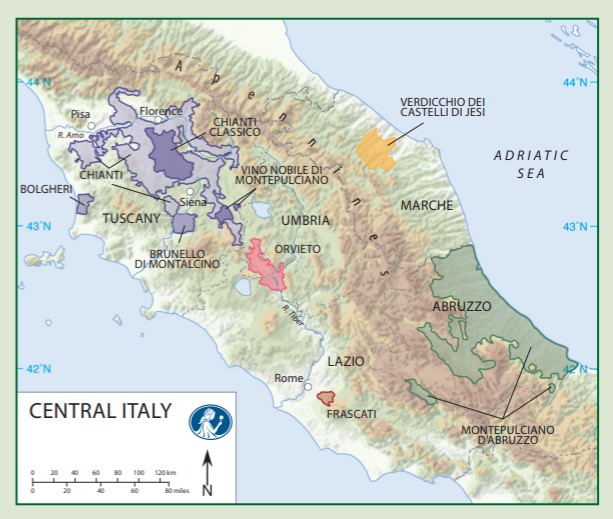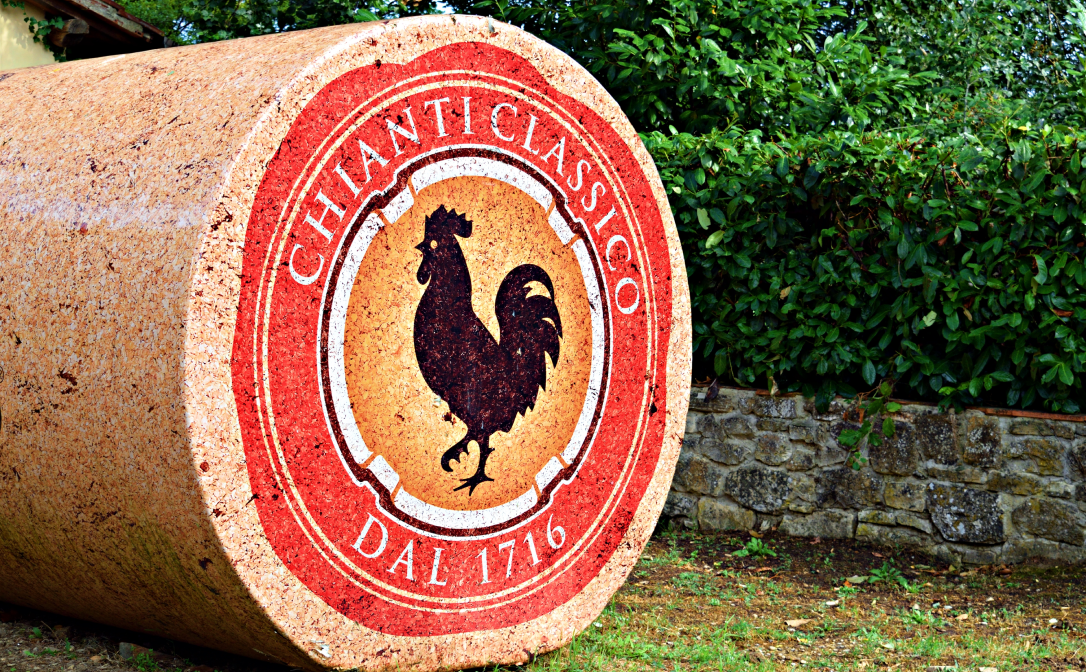National Chianti Day provides wine lovers with the perfect opportunity to savour a glass of this popular Tuscan red. The eagerly anticipated celebration of Sangiovese is observed on the first Friday in September each year.
It started out as an American event, which was established by the US importer of renowned producer Santa Margherita. However, to paraphrase Bill Pullman as President Whitmore in the Hollywood blockbuster Independence Day, this annual celebration is no longer an American holiday, but the day when the wine world declares in one voice: “We will enjoy our Chianti!”
The occasion also offers the chance to learn more about these wines, which range from fresh, simple Chianti to the magnificent Chianti Classico Gran Selezione Il Caggio Ipsus. This guide explains everything you need to know about the classifications, regulations and key historical milestones in this famous Italian region.
Chianti denominations in a nutshell
There are two separate Chianti denominations:
- Chianti DOCG
- Chianti Classico DOCG
The Chianti Classico DOCG covers the historical heartland of the region, which lies between Florence and Siena in Tuscany. Winemakers in this region are subject to stricter ageing and blending requirements than their counterparts in the Chianti DOCG. The Chianti Classico DOCG has a reputation for producing complex, structured, and age-worthy wines.

The Tuscan landscape between Siena and Florence.
Meanwhile, the larger Chianti DOCG covers a far broader and more diverse range of terroirs across Tuscany. This region surrounds the Chianti Classico DOCG, but it also stretches west towards Pisa and south to Siena. The Chianti DOCG has less stringent ageing and blending requirements, and the level of quality can vary significantly within the region.
We will explore the differences between the Chianti DOCG and the Chianti Classico DOCG in greater detail below, but first, let’s delve into the history of Chianti.
The history of Chianti
Wine has been produced in the region since at least the 13th century. During the Middle Ages, the villages of Castellina, Gaiole and Radda joined forces to create the League of Chianti.
However, the modern Chianti industry began in earnest back in 1716, when Cosimo III de' Medici – the Duke of Tuscany – issued an edict delineating the boundaries of what would eventually become the Chianti Classico region.
For many years, Chianti specifically referred to wines produced in the area now known as Chianti Classico. Yet that all changed during the 19th century, when the term “Chianti” began to be applied more broadly to wines produced outside the original delineated area, covering a far larger part of Tuscany. Purists argued that this diluted the Chianti brand.
The Italian government established the DOC (Denominazione di Origine Controllata) system in the 1960s, and the entire Chianti region was granted DOC status. The Chianti Classico area was one of several sub-regions within the Chianti DOC.
In 1984, Chianti was elevated to the more prestigious DOCG (Denominazione di Origine Controllata e Garantita) status. Meanwhile, Chianti Classico was separated from the rest of the region and awarded its own DOCG ranking. That allowed Chianti Classico to be officially recognised as a distinct designation with a reputation for higher-quality wines.
Key differences between Chianti and Chianti Classico
There are several key differences between Chianti and Chianti Classico. We can divide them into five broad categories: geography and terroir, blending, ageing and designations, labelling, and quality and reputation. We have explored each category in detail below.
Geographical Boundaries, Sub-Regions and Terroir
The Chianti DOCG covers approximately 15,500 hectares of vineyards. There are around 3,000 producers, and average annual production is roughly 800,000 hectolitres.
This denomination encompasses a large area, with multiple sub-zones:
- Colli Fiorentini, located just south of Florence.
- Chianti Rufina, in the northeast of the region.
- Colli Aretini, found in the Arezzo province to the east.
- Colli Senesi, south of the Chianti Classico DOCG in the Siena Hills.
- Colline Pisane, the westernmost sub-zone, located in the province of Pisa.
- Montespertoli, a smaller sub-zone within Colli Fiorentini.
- Montalbano, in the northwest of the DOCG.
Wines labelled as Chianti can be made from a blend of these sub-zones, and they can include grapes from peripheral areas.
The soils, elevations and microclimates vary significantly within the Chianti DOCG. For example, the wines in Colli Senesi tend to be fruit forward, with softer tannins, as a result of the warm climate and predominantly clay soils.
By contrast, the Chianti Rufina sub-zone is located at a higher altitude, with cooler temperatures and rocky, mineral-rich soils, leading to more structured wines with greater acidity and ageing potential.
It is also interesting to note that Colli Senesi overlaps some of Tuscany’s most famous areas, including Brunello di Montalcino and Vino Nobile di Montepulciano. However, Colli Senesi covers the Sangiovese-based wines from the less prestigious vineyards of the area.
Meanwhile, the Chianti Classico DOCG only comprises approximately 6,800 hectares of vineyards. There are around 350 producers, and annual production is typically between 255,000 and 285,000 hectolitres.
This is a historically significant area, slap bang in the middle of the Chianti region. The vineyards in Chianti Classico are typically located at higher altitudes than those in the Chianti DOCG. These are some of the features:
- Location: The Chianti Classico region, while still diverse, is more geographically concentrated than the broader Chianti DOCG. The vineyards are typically located at between 250 and 600 meters above sea level.
- Soils: The soils are predominantly Galestro and Alberse. Galestro soils are brittle, rocky and rich in limestone, whereas Alberse is compact, clay-rich soil. Both drain well, and they are ideal for the cultivation of Sangiovese.
- Climate: Chianti Classico benefits from a continental climate, with significant diurnal temperature variation. That helps preserve acidity and freshness in the grapes, and it promotes the development of complex flavours.
Chianti Classico has more consistent terroir than the Chianti DOCG, as it is in a smaller and more concentrated area. The terroir often imparts distinctive notes of cherry, violet, and herbs, frequently with a mineral backbone that is a hallmark of Chianti Classico wines.

The central Italy wine region, including Chianti Classico in the purple area.
Blending regulations
Chianti DOCG wines must contain at least 70% Sangiovese, which is the primary grape variety of the region.
The rest can be made up of local and international varieties, from Cabernet Franc, Cabernet Sauvignon, Merlot and Syrah to Canaiolo Nero, Ciliegiolo, Colorino, Foglia Tonda, Malvasia Nera, Mammolo and Pugnitello.
The Chianti DOCG allows producers to use a maximum of 15% Cabernet Sauvignon and/or Cabernet Franc in the blend. They can use no more than 10% Malvasia and Trebbiano, which are white grape varieties.
Chianti Classico DOCG wines have stricter regulations. They must contain at least 80% Sangiovese, and the remainder can be made up of other approved red varieties. No white grapes are permitted in the blend.
Most Chianti Classico producers focus heavily on Sangiovese. Some wines use 100% Sangiovese, and many others only feature a minimal percentage of alternative grapes.
From 2027, Chianti Classico Gran Selezione wines will be required to have at least 90% Sangiovese in the blend. We will explain what Gran Selezione means later.
Ageing regulations and designations
Chianti DOCG wines have less stringent ageing requirements than their Chianti Classico cousins.
Basic Chianti DOCG wines can be released as early as 1st March in the year following the harvest. That means many of these wines are enjoyed in their youth as fresh, simple reds.
However, there are three classifications within the Chianti DOCG:
- Chianti: The simplest wines in the DOCG.
- Chianti Superiore: A higher-quality designation within the Chianti DOCG. These wines must be aged for at least nine months, including a minimum of three months in bottle.
- Chianti Riserva: These are the best wines in the Chianti DOCG. They must be aged for a minimum of 24 months, including at least three months in bottle.
Chianti Classico wines are subject to more rigorous ageing requirements. There are three tiers:
- Annata: These are the standard Chianti Classico wines, which must be aged for a minimum of 12 months.
- Riserva: Higher-quality wines, which must be aged for at least 24 months, with a minimum of three months in bottle.
- Gran Selezione: This is the highest quality designation within Chianti Classico, introduced in 2013. Gran Selezione wines must be aged for a minimum of 30 months, including at least three months in bottle. These wines must also be produced from estate-grown grapes. Recent changes to the category introduced 11 sub-zones.
Chianti labelling
Chianti DOCG wines typically feature the “Chianti” name prominently on the label. This is often accompanied by the sub-region, such as Chianti Rufina or Chianti Colli Senesi, if applicable.
They have a numbered DOCG seal, which is typically attached to the neck of the bottle. This confirms the wine’s certification and compliance with the DOCG regulations.
Chianti Classico wines usually feature the Gallo Nero emblem. This black rooster is the historic symbol of the region, and it signifies the wine’s origin in the Chianti Classico DOCG.
You will normally find the “Chianti Classico” name on the label too, along with the numbered DOCG seal. The label may also specify the classification within Chianti Classico, such as Riserva or Gran Selezione.

The famous black rooster, or Gallo Nero, emblem.
Quality and reputation
The quality within the Chianti DOCG can vary widely. There are some excellent producers in the region, particularly in the Chianti Rufina sub-zone, but it is predominantly renowned for producing simple, affordable and accessible red wines.
On the other hand, the Chianti Classico DOCG has a reputation for producing some of the best Sangiovese-based wines in the world. The stricter regulations, the superior terroir and the smaller, more defined area of production typically result in higher-quality wines that offer greater consistency.
These wines are often more complex, structured and age-worthy than their counterparts from the broader Chianti DOCG.
The Gran Selezione designation represents the pinnacle of Chianti Classico wines. Some of the best examples include Il Caggio Ipsus 2016, Castello di Radda Vigna Il Corno 2016 and Castello di Fonterutoli 2018.
However, you don’t need to splash out on those elite wines to enjoy a superb glass of red on Chianti Day, as it is not too difficult to find impressive wines throughout the Chianti Classico DOCG.
Our Level 3 Award in Wines offers an in-depth look at various wine regions and styles.
This guide was prepared by drinks journalist Martin Green.


